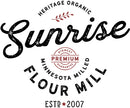Scoring your bread
Many bread bakers, especially those who are new to bread baking, ask us about scoring and why it’s important.
What makes dough rise is the build-up of CO2 as it develops during proofing. Once the dough goes in the oven, this process continues. If you don’t give the gas a place to release, it will escape however it chooses. Scoring gives you control over where the gas escapes. It also adds a decorative touch to your loaf.
You can purchase a lame as part of either of our Bread Kit bundles (Standard or Deluxe), or on it's own.
Tips for Scoring Bread:
Use a Sharp Blade: It’s important to use a sharp blade if you want nice clean cuts. If your blade is dull, it can drag on the dough, resulting in the dough tearing rather than those nice clean cuts. A lame or a super sharp knife work really well.
Score Quickly and Confidently: Now is not the time to be timid! Make swift and confident cuts. I swear bread dough can sense hesitation and decide to give you jagged edges. ;) However, there is a balance of being quick but gentle. Slashing too deeply or too forcefully will deflate the dough.
Experiment with Patterns: Like we discussed earlier, scoring bread helps control the expansion during baking. This is also the part of the process where your creative side can flourish! Try different scoring patterns to see what works AND looks best in your opinion.
Consider Dough Temperature: The temperature of your dough affects how it will score. People have different preferences but we have found that cold dough scores easier! Experiment with different dough temperatures to see what works best for you.
Keep Hydration in Mind: Higher hydration doughs are more delicate and sticky which can make them more challenging to score. Depending on your goals- adjusting your hydration can help you get a cleaner score.
Choose the Right Angle: The angle you hold the blade matters. Experiment with different angles to achieve the desired effect. If you hold the blade between your thumb and forefingers loosely, and turn your wrist so the blade is at a 30-45 degree angle - you will get great cuts.
Depth of the Cuts: For most artisan bread, aim for cuts that are about 1/4 to 1/2 inch deep. Deeper cuts allow the bread to expand more during baking, creating a more dramatic "ear.". If you cut the dough too deeply it will affect the gluten structure and your dough will deflate.
Keep it Simple: When you're just getting started, keep your scoring simple before you start playing Picasso. Once you get the hang of it- then try more intricate designs. Simple cuts can still result in beautiful loaves too :)
Practice: Like any skill, scoring takes practice. Don't be too hard on yourself if your first few loaves aren't A+ loaves. Keep on experimenting and adjusting your technique. Use some leftover dough to practice!
All for now,














